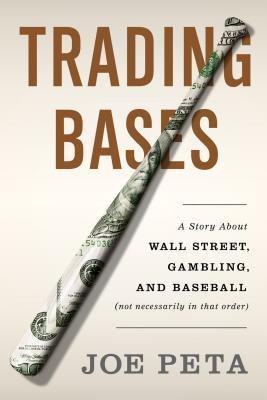
Joe Peta's book, 'Trading Bases', is based on Joe's baseball hedge fund in which the injured Stanford graduate looks to gain capital with a mathematical edge over the Las Vegas based bookies. Joe is very explicit throughout the book with regard to how he built his predictive algorithm and how he managed risk. This book has been very beneficial for me in managing cryptocurrency based investment portfolios and it probably holds a level of value for those looking to invest with quantified evidence. Alas, here are the three main take out points!
1. Cluster Luck and it's Misleading Meaning

Take the picture above. Four dice are pictured. Now imagine we roll these dice simultaneously one hundred times over. How many times will the total roll exceed 13? It should be exactly 50 times 12 or below and 50 times above 13. But this is not always the case. Sometimes there may be large deviations from the mean. In baseball, this is exemplified by runs scored. A team may have bases loaded and be struck out. In the next innings, they may score a homerun with no one on base. This simple difference equates for a difference of three runs, based on when the home run is scored (4 for bases loaded homer, 1 for no one on base). Luck is of significant consequence in sport. Peta recognised this factoid and was thus able to quantify the expected win total whilst stripping away the luck factor. He found that Tampa Bay were particularly lucky during the 2010 season and expected them to score 100 hundred less runs. They ended up scoring 95 less.
2. The James' Pythagorean Theorem for Baseball and Beyond

Every single modeller will have their own slant or variation on why things occur. However, nearly all Baseball enthusiasts subscribe to the advised Bill James based principle.
Runs Scored^1.83/(Runs Scored^1.83 + Runs Allowed^1.83) = Team Winning Percentage
Just think about this for a second. Over the course of hundreds of matches worth of data, I'm able to depict with relative certainty the success of the team. This is an exceptional equation that perhaps has not been given as much acclaim as it possibly should on the global context. The beauty of these numbers is that they can be altered to suit any sport that is based on a point or goal output. Soccer is one such sport which has considered the Pythagorean Theorem. In a brilliant piece over on StatsBomb, the Pythagorean Equation is considered to be Goals for^1.2/(Goals for^1.2+ Goals against^1.2). There are also relevant adaptations for sports such as Basketball and Australian Rules Football to be found with a quick google search. Peta uses this equation as his basis for identifying whether teams under or over performed on last season.
3. Invest in True Odds Rather Than Outcome Expectations

This picture perhaps best illustrates Peta's thought process. Above is a picture of rocks, each with a different colour. Clearly the vast majority are grey with the odd few purple. Now if someone asked you to close your eyes and pick one rock at random, how likely do you believe that your selection will be a purple rock? For the sake of the example, lets assume that there is 45 rocks and 5 are purple, totalling 50 rocks. There is a 1 in 10 chance that you pick purple. However, would you place a wager if I offered you a payout of $100 for a $5 bet? Think about it... The odds are stacked against you, but what do you choose?
The answer from a mathematical standpoint is yes. Whilst the likelihood is that you'll lose, the true odds are stacked heavily in your favour. The implied odds are 5% but the true odds are 10%. That means you have a 5% edge, or relative value, within this particular example. Joe considers his time as an options trader and reveals how important this mindset is for someone in that role. Relative value is more important than probable value and helps strip away the emotion from decision making.
4. The Fundamental Requirement for Risk Management

There have been plenty of books and blogs pertaining to the idea around risk management in the investing world. Risking too much can see you with no fund to speak of in a short period of time. Opposingly, an inadequate amount of capital placed on your decisions may plague your bottom dollar yields. The above picture illustrates this point perfectly. These two clearly have different feelings toward skydiving. The yellow, happy as Larry fella, is at an optimal place in his risk management strategy. He has taken a risk by hurtling to the ground at hundreds of kilometers per hour. His risk is not too catastrophic that he doesn't live to see the end of the day, but he also hasn't undershot by fulfilling his daredevil needs. However, the man wearing black is a little further down the risk end of this equation.
Joe Peta based his 'capital risked' decisions based on the relative value of each placed wager. Wagers that had an implied relative value in excess of 15% demanded 2% of the fund. Whilst a relative value between 0-3% garnered just 0.1% of the capital. Each individual's risk assessment will differ and will be altered based on what is being invested on. For instance, in the MLB each team plays 162 matches per season. This gives a phenomenal amount of opportunities to trade on the outcome. However, if your capital is focussed toward the NFL season, you may need to take more risk due to the lower amount of available trading opportunities (16 games per team during the regular season). Each situation will provide an opposing set outcome. However, being aware of the potential for negative variance is something that should be at the forefront of every investor's mind. Those that can survive it and move forward will be most prosperous!
For those looking to find out more about Joe Peta, he has a talk from MIT Sloan available and an individual interview published by blogger Benjamin Cronin.
Thanks once again for taking time out of your day to read these words. I look forward to posting up a book review from time to time. As always, a special thank you to my followers and those re-steemers! Let me know in the comments below which book you would like reviewed in the future.